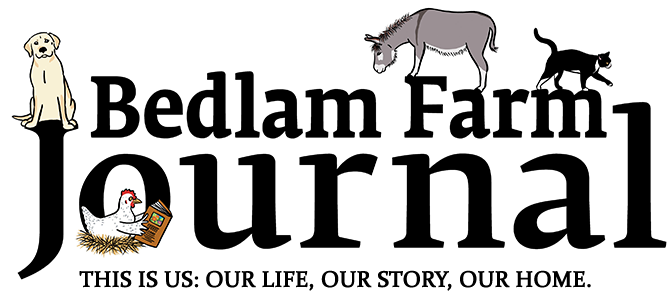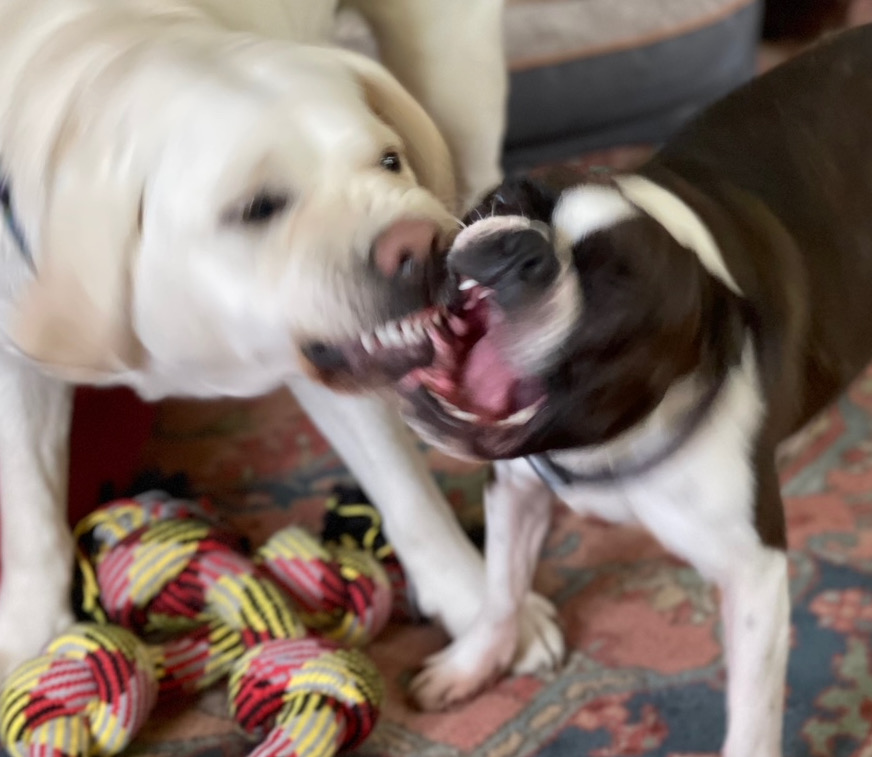Play is a critically important aspect of the social behavior of dogs. Dogs play in different ways, with one another and with humans. In the chosen play is thoughtful; we can make our dogs smarter by playing.
For Zinnia and Bud, the play has been important in their adaptation to our farm (Bud is a rescue from Arkansas, Zinnia, from a breeder in Connecticut).
My border collies loved to play when they were young, but as they get older, play is more fleeting, work is more central.
For Bud, two years old and battered and sick when he arrived, Zinnia offered a safe and gentle playmate, a companion to lean on, a dog to help show him how to live in a house, which he had only done while ill, and be comfortable around men, with whom he was very skittish.
Zinnia is a playful and active dog, and she and Bud have taught each other playing signals and an opportunity to run for hours outside. This makes both of them calmer and more peaceful inside. She has also taught Bud to be calm in the house.
According to James Serpell, author of The Domestic Dog, dog play is generally a positive force in dog’s lives; it reduces social tension, is indicative of what he calls “positive well being,” makes a human-dog relationship more successful, reaches dogs to think, manipulate objects and in some cases, teaches hunting and capture behaviors.
Like everything in the life of dogs, play can be overdone. It can over arouse dogs, bring up too much prey drive, use teeth too much, and create obnoxious and addictive behaviors inside the house.
Some dogs learn to bite in play (if they get to put their mouth on humans), others have trouble differentiating play signals from aggressive ones in other dogs.
In his book The Intelligence Of Dogs, psychologist Stanley Coren recommends retrieving games as stimulating and useful.
“Just remember to use words like “fetch” or “take” when throwing the object and “give” or “out” when removing the object from the dog’s mouth. (I use “drop.”)
People should be careful during play to never allow the dog to “play attack” or use its teeth. Don’t play tug-of-war; that can promote aggression and fighting.
Konrad Lorenz, the Nobel-Prize winning authority on animal psychology, claims that playful animals learn to manipulate animate and inanimate objects.
Play, he has found, develops a dog’s mind by leading it to new and novel situations where it has to think and innovate. Any new experience stimulates the dog’s mental development and intelligence.
“If you choose the games that you play with your dog thoughtfully,” writes Coren, “you will actually be creating a more intelligent dog.”
But be thoughtful. I am sometimes play with my dogs, but apart from ball throwing outside for Zinnia, I rarely play with them. Dogs are better at that than I am.
The working breeds – border collies, labs, retrievers, standard poodles – can become addictive to human-dog playing activities like ball chasing and tug-of-war.
For these reasons, I confine most play activities involving dogs and toys to the outside.
Inside the house is for calm or quiet playing with each other; they don’t need balls for that.
Suppose it goes on too long or gets too loud: then time-out, crate time.
I’ve had labs who are addicted to ball throwing, and they can make life inside the house obnoxious and annoying. Just as I never feed dogs anything from the table, I never throw a ball inside the house.
For the high-end working breeds, one ball toss is fine; two is an addiction and obsession. If they want to play at any time, they can go to the door and take it outside.
Play is believed to peak in puppyhood at 8-9 weeks of age.
It frequently continues into adulthood for several years – that varies according to breed and early training.
Researchers have found that adult wolves play almost to the end of their lives, which suggests it benefits canids in general.
Dogs use visual signals to begin to play. These are sometimes hard for humans to spot and even confuse other dogs. Some dogs can confuse sudden play with aggression and get ready to fight rather than play.
Play signals involve a wide range of visual signals. One is the “play face,” characterized by the mouth being held open with unretracted lips slightly exposing unclenched teeth” (you can see this in the photo above of Zinna and Bud playing).
Another – called the “play bow” involves the dog crouching on its forelegs and elevating its hind-end up in the air, a position sometimes called the “downward dog” in yoga or the “child’s pose.”
Other play signals include face pawing (extending a forelimb toward a playmate’s face or exaggerated approaches made with a loose, bouncy gait faster than walking but slower than running.
“Face signals” are often the determining factor in whether one dog will want to play with another. Lots of dogs would rather smell stuff on the ground.
Dogs are keenly sensitive to the attitudes of a potential play partner. They will use attention-getting behaviors like barking or jumping up and down when a playmate is facing away and playing signals only when facing the other dogs and getting some response.
Humans often try to force or encourage dogs to play in the same way parents nag their kids to find other kids to play with. It rarely works with kids or dogs. That kind of pressure often makes dogs tense, not playful and can lead to warnings, even fighting.
The point is to give them what they need, not what we need.
Let the dog – especially puppies – learn to play naturally and early on. It’s a key element of socialization. Lots of dogs grow out of playing as they get older. Many dogs don’t want to do it.
I intensely socialize new dogs, especially puppies, and then pull back as they approach six to eight months. I see a lot of dogs over-aroused by too much play or made dog-to-dog aggressive when their prey drive gets too high, as it can do if there’s too much-unchecked playing with too many dogs.
No dog needs hours of play every day. A half-hour to 45 minutes is plenty.
I’ve learned to read many play signals; it is endlessly fascinating to me to learn how dogs communicate with one another. They do not use words, something I always need to remember.
Dog play rarely goes with good training. sessions It’s a distraction, and it cranks the dog up when you want to slow the dog down so he or she can pay attention.
I’ve learned to be careful to separate what pleases me from what the dog needs.
Young dogs need to play to be socialized and learn how to manipulate things and trust other dogs. Older dogs only need to play if they want to.


I’ve always played tug with my dogs and use the “out” command to end the session. As soon as the dog drops the toy, I pick it up and throw it, thus turning a game of tug into a game of fetch so the dog is always very willing to drop the toy. A tired dog is a happy dog AND a happy human! ?